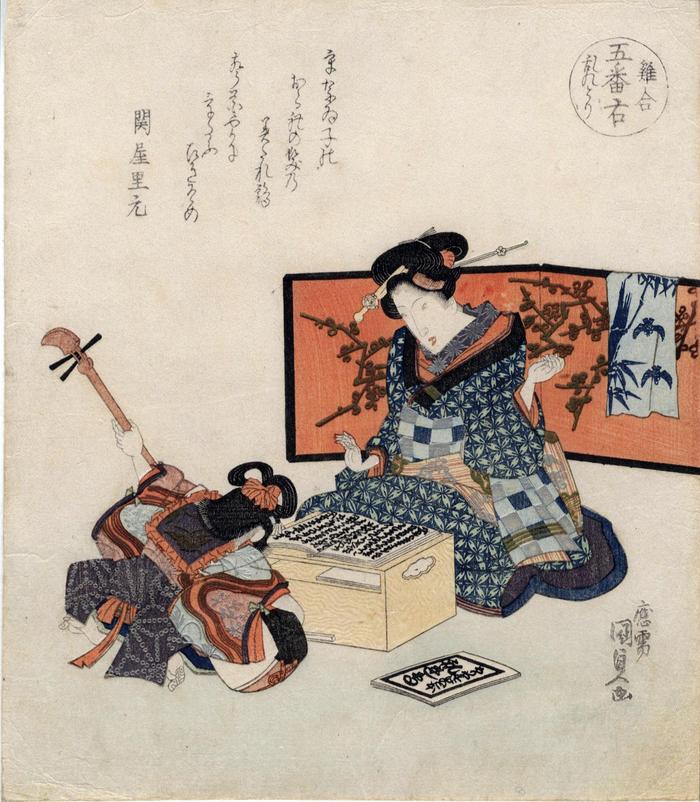Utagawa Kunisada (歌川国貞) / Toyokuni III (三代豊国) (artist 1786 – 01/12/1865)
"Tori Awase (雞合) - Goban migi (五番右), Midare Dori" - with a poem is by Sekiya Satomoto (関屋里元)
1825
7.68 in x 8.78 in (Overall dimensions) Japanese color woodblock print
Signed: ōju Kunisada ga (應需国貞画)
Royal Museums of Art and History, Belgium (via Cultural Japan) There is another copy of this print at the Fitzwilliam Museum. Their curatorial files note:
"From the series of fifteen Spring kyoka surimono entitled Tori-awase (A contest of fowls), commissioned by the Taiko poetry group for the year of the cock. The series involved pictorial puns on the name of varieties of birds. It was unusual in that it consisted of six pairs of prints (right and left) designed by Shinsai and Kunisada, and a triptych by Hokkei. The pair to this print has not been identified. 'Mixed cock-crows' (midare-dori) was a poetic term expressing a time late in the dawn; it is also the title on the cover of the Meriyasu keiko-bon (instruction manual for popular ballads) which the young girl is using for her shamisen lesson. She is dressed up in a new kimono and with her hair arranged for the first music lesson of the New Year. Music was often taught by female instructors, particularly popular music."
****
It should be noted that in a lecture, 'The Poetics of Inscribed Kabuki Actor Prints', viewable on YouTube, by John T. Carpenter said that the three-string shamisen was "the most common instrument of the Yoshiwara brothels as well as kabuki and among geisha."
****
The term tori awase is a reference to a cock fight, indicating that this surimono was produced for the Year of the Cock. The young girl playing the samisen is performing the song Midaetori or 'various crowing cocks'.
While we don't as yet have a translation of Satomoto's poem we might find a clue in the blue and white hand towel thrown over the top of the low screen behind the woman. It shows the motif of flying sparrows and bamboo (takesuzume - 竹雀), a common theme in Japanese art and culture. The screen is decorated with a flowering plum or prunus, a symbol of spring.
****
Sekiya Satomoto was active in the early 19th century. We know that he was from Senjū, to the northeast of Edo. He was known to have commissioned particular surimono and to have provided some of the poems on them. The artist included Kiitsu and Kuniyoshi, too.
****
The Museum of Fine Arts in Boston says of this series: "The series apparently consisted of a total of 15 sheets by three different artists. Twelve sheets by Kunisada and Shinsai used the format of a poetry contest between Left and Right sides, in six rounds, with subtitles based on the names of varieties of chickens. There was also a triptych by Hokkei showing a cockfight."
surimono - 摺物 (genre)
beautiful women (bijin-ga - 美人画) (genre)
